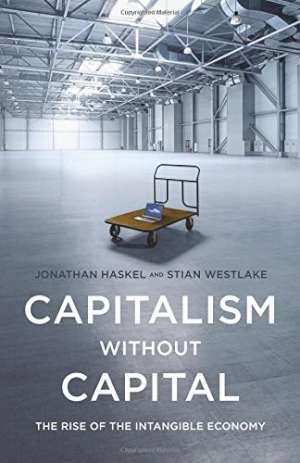09 July 2018
Capitalism without Capital
The rise of the intangible economy
Jonathan Haskel & Stian Westlake
2018, Princeton University Press, 288 pages,
ISBN 9780691175034
Reviewer: Matthew Whittaker

Think about some of the world’s largest companies – Apple, Amazon, Microsoft and Facebook, for instance – and ask yourself where their value lies. Not, in the main, in the traditional business assets of plant, machinery, computers and physical products. Instead, these companies excel in things that are harder to touch, like software, designs, ideas and brands. And it’s not just in our leading firms and highest-tech industries where this phenomenon is present: relative to their 20th century counterparts, businesses such as fast food restaurants, supermarkets and pet stores are placing an increasing emphasis on data, organisational processes and market research. So much so that intangible investment now outweighs tangible in many advanced economies – including the UK.
That what we value in firms has shifted is not in itself that startling a revelation. This transformation might, however, alter the functioning of our economy in a way that is profound enough to change our approach to investment, regulation and public policy. And yet that change in approach appears to be insufficiently developed. That at least is the argument that sits at the heart of this thought-provoking and entertaining book from Jonathan Haskel of Imperial College (and, from September, the Bank of England’s MPC) and Stian Westlake of Nesta.
They believe that the rise of intangible investment produces many and varied consequences, all stemming from the “Four S’s” of scalability, sunkenness, spillovers and synergies.
‘Scalability’ relates to the fact that intangible investment can be rolled out in a way that tangible investment cannot (compare the building of a new factory versus the development of a new app that can be downloaded an unlimited number of times for instance). ‘Sunkenness’ reflects the fact that intangible investment typically has lower resale value than tangible (if all goes wrong, the factory can be sold but the failed app can’t). ‘Spillovers’ too are more common in the intangible world, with rivals better-placed to benefit from other firms’ investments (the factory can be locked and secured, whereas the app could be imitated). And the benefits of ‘synergies’, while present in the tangible world too, are more obvious in relation to intangible investment (a newly-developed app is significantly more valuable when combined with investment in smart phone technology for example).
It is a line of thinking that the authors show can provide useful insights into a number of features of the modern economy. Why have we seen the rise of large, superstar firms and increasing business concentration? Perhaps because investments are more scalable and because the heightened presence of spillovers places a premium on those firms that can protect their position (for example, by swooping in and buying smaller ventures each time they produce a good idea). Why are investment levels so subdued at a time of low borrowing costs? Maybe the sunk costs and spillovers inherent in intangible investment put all but the biggest firms off taking a risk. Indeed, the lack of a sellable physical output at the end of the investment might make it harder to raise finance through the usual channels in the first place.
More generally, Haskel and Westlake argue that the four S’s result in increased “uncertainty” and “contestedness”, fundamentally changing how our economy works. That is, intangible-intensive investment is more costly if it goes wrong, more rewarding when it works, harder to value ahead of time, and more likely to create outputs that are fought over.
In setting out this argument, the authors must be given great credit for doing three things that are all too often absent in other economics books of this kind.
First, they recognise the limitations of their own approach. Rather than claiming that the rise of intangibles offers an explanation for everything, the authors are careful to point out that theirs is but one perspective worth considering. Second, they are generous and thorough in their treatment of others’ research. The book sets out descriptions of previous findings that are detailed enough to make the reader feel like they don’t need to seek out the original, but engaging enough to encourage them to do so anyway.
Third, they go beyond describing the challenge by additionally setting out a preferred and practical – rather than simply rhetorical – response. From improving rules and norms around intellectual property rights and changing the financial architecture of the modern economy to favour equity over debt, to redesigning our approach to urban planning and placing renewed emphasis on skills development, the discussion in the policy chapter could easily fuel a book in its own right.
Readers will inevitably disagree with some of the book’s conclusions: certainly some of the arguments are more convincing than others, and many of the recommendations are far from straightforward to implement. But it will be hard for anyone to read the book and not conclude that our institutions haven’t yet caught up with the changing world around them – but that they should. Capitalism Without Capital is one of those rare economics books that develops an idea rather than simply asserting the same thing on every page. It rewards careful reading and is likely, without the fanfare that surrounds some other works, to change the direction of economic debate for the better.
